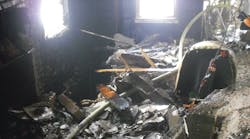By this time, you will probably have arrived at a simple conclusion. Firefighting is a dirty and dangerous job. We must all acknowledge this fact. We must the work very hard at training for those times when the challenge is the greatest. Cellar fires provide just that confrontation.
It has been our experience that many buildings are destroyed by fires that started in basements. To understand the problem you must first visualize the general conditions that exist. Firefighting in these situations is usually more effective when it is done from an interior stairway.
This stairway is often located in the middle of the building. Add to this the fact that there is normally a great deal of smoke and heat rising through that door and you begin to see the severity of the hazard you are about to encounter.
Generally speaking the contents in a cellar lead to a very hot and smoky fire. It has been our experience that the combustion process is slower and that there is usually a lack of oxygen.
It is this lack of oxygen that contributes to the density and severity of the smoke, through incomplete combustion. There is frequently a delayed alarm problem, because of the fact that building occupants usually do not discover a cellar fire in a timely fashion. They tend to be fairly well advanced by the time of the fire department's arrival.
Compounding the problem is the draft effect caused by smoke moving up through the interior staircase. Firefighters are faced with a situation similar to attacking a fireplace fire down the mouth of the chimney. Many times the discovery of cellar fires is delayed because they begin to burn way back away from where someone might see them.
You are going to face a situation where ventilation is limited because there are not many openings in the average basement. If you are fortunate, there might be two doors and a couple of windows. In the absence of good fortune, you might find yourself attacking down the ONLY stairway into a windowless basement; or worse yet, a sub-basement.
Self-contained breathing apparatus is an absolute necessity. In addition to the standard array of toxic vapors and gases you would face at any normal fire, you have the potential for an oxygen-deficient atmosphere in a below-grade area.
Putting water on the fire can be a hit or miss proposal. I have often heard it said that you can’t hit see it that it is not possible for you to hit it. A cellar fire is a prime example of this old axiom.
Not only can you not see the fire, you might not even be able to see the obstructions that could deflect your water away from where it could do the most good. It has been our experience that it is hard to decide whether the fire is moving up beyond the reach of your hose streams.
Construction also plays a critical part in your success at attacking and extinguishing a cellar fire. If the building is of balloon frame construction, your first clue to that effect might be fire on an upper floor. This would hold true for elevator and dumbwaiter shafts, and various pipe chases and utility shafts. Anticipate that heat and smoke will do the natural thing and rise upward in the building.
All floors above the cellar are at risk as well as any people in those areas above the fire. You may need to get a hoseline between the fire and the people to allow for a safe exit. You must search and ventilate these upper floors to insure that everyone gets out. This will eat up a hearty share of your manpower resources, so think about extra help early on in the operation.
Cellar fires are often difficult to penetrate with hand lines. Therefore firemen sometimes must resort to lines from windows and doorways, or cellar pipes from above. However, your best chance at early control and extinguishment comes from an aggressive attack down the interior stairway to the seat of the fire.
To do this may require your advancing two or three lines abreast into the hottest and smokiest part of the fire. We have found this to be at the top of stairway leading to the basement. Ideally, there will be a second stairway which can be used to vent heat, steam and smoke from the basement as your attack advances in on the fire.
Be very careful. If there is no second entrance, the heat and steam from your attack can blow right back into your face. Regardless of how you proceed with your attack, a line must be placed to protect the interior of the building from any fire which seeks to burn up and out of the inside stairway door. If you cannot make entrance into the basement for a quick attack, leave the door to the cellar closed and place a line to protect that point, in case the fire burns through the door before your alternate plan of attack can work.
What could constitute your alternate plan? In many cases, you would have to resort to opening holes in the floor above the seat of the fire and inserting cellar nozzles or Bresnan distributors down into the cellar space.
We can remember an incident where this tactic saved a very old, Catholic Church in community inNew Jersey. Holes were cut, lines were stretched and a Bresnan distributor was placed in the way of the fire's progress. The fire was stopped in its tracks.
As you attack remember two key points. It is critical to ventilate these fires. And you must provide a second line at the rear. You must let the heat and smoke out. You also need to provide a line at the rear. This line is usually not used to attack the fire, as it could lead to opposing streams. But it is available to protect against exterior fire spread.
A cellar fire may well be the toughest job you ever have to face. There is no other way to be ready for one than to learn your business, drill regularly and recognize the signs that can tell you that you are facing a cellar fire.
Other than flames and smoke coming directly out of the cellar windows, the best clue to a cellar fire is coming upon a building where smoke is coming from every level of the structure. In all of our years of firefighting, we have never personally seen this clue fail to warn of a cellar fire.
Let us look at our approach, as it applies to cellar fires:
- What have I got? A structural fire
- Where is it? Below grade
- Where is it going? It will go up until it hits a blockage and then laterally. Remember that old buildings may have balloon frames that really speed up this trip. (Think about the fact that in certain newer buildings, contractors have been know to violate the integrity of walls in a variety of ways: Be on guard!)
- What forces are available to combat this threat? What is your standard response and is it enough for the fire you find? Let that be the starting point for your decision-making process.
- What can I do? Deploy your forces to best advantage. Call help. Constantly observe and evaluate the progress of your forces. If there is the least doubt in your mind as to the safety of your people, pull them out and go to a defensive operation.
Although we tend to think of ourselves in macho terms, never endanger your people just to protect property. We can replace a building, but not a human life.
In summary, cellar fires are tough and nasty affairs. They are an instance where your skill and experience will be called directly into play in a tough and dirty up-close battle. Know these facts and be ready.








